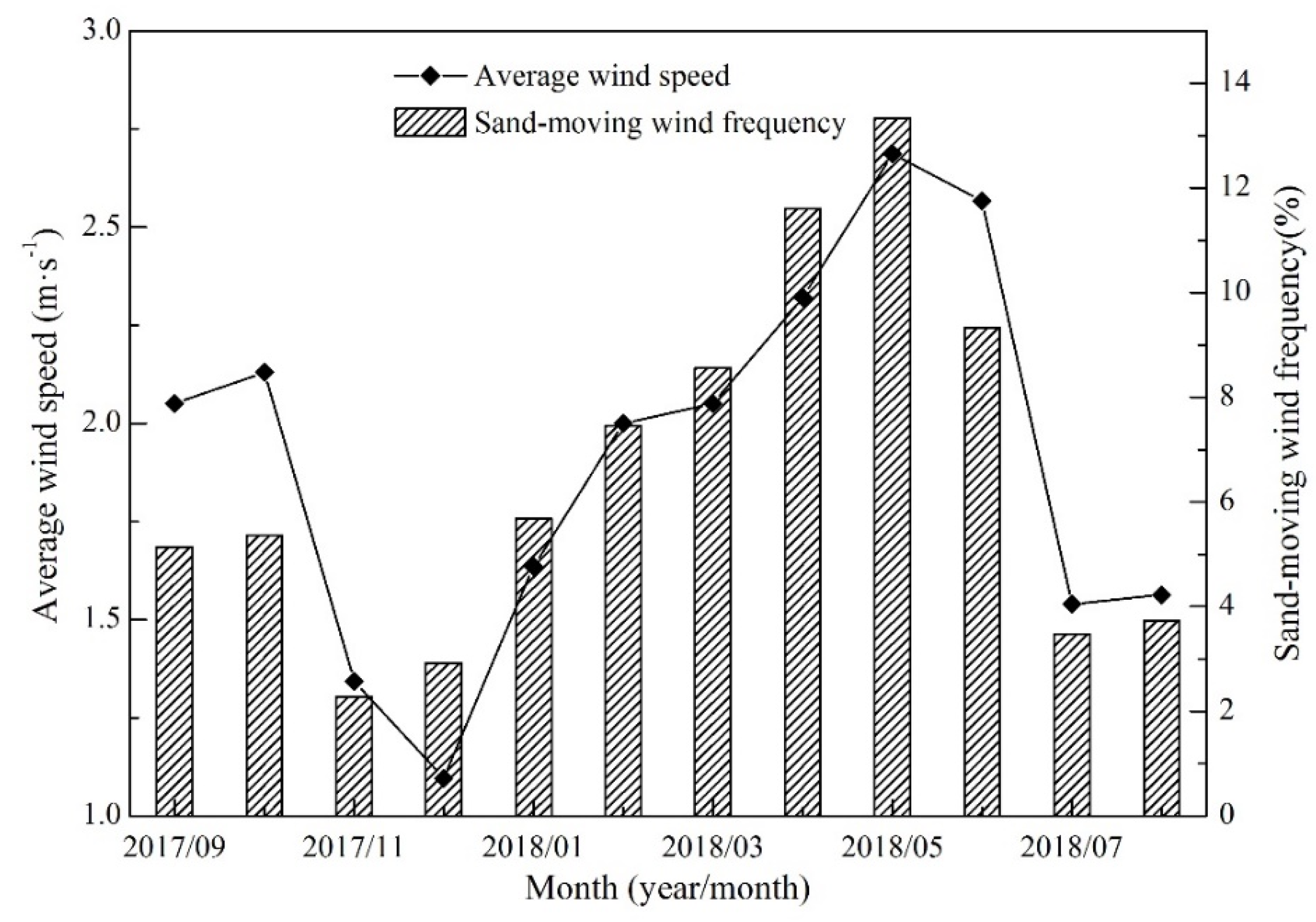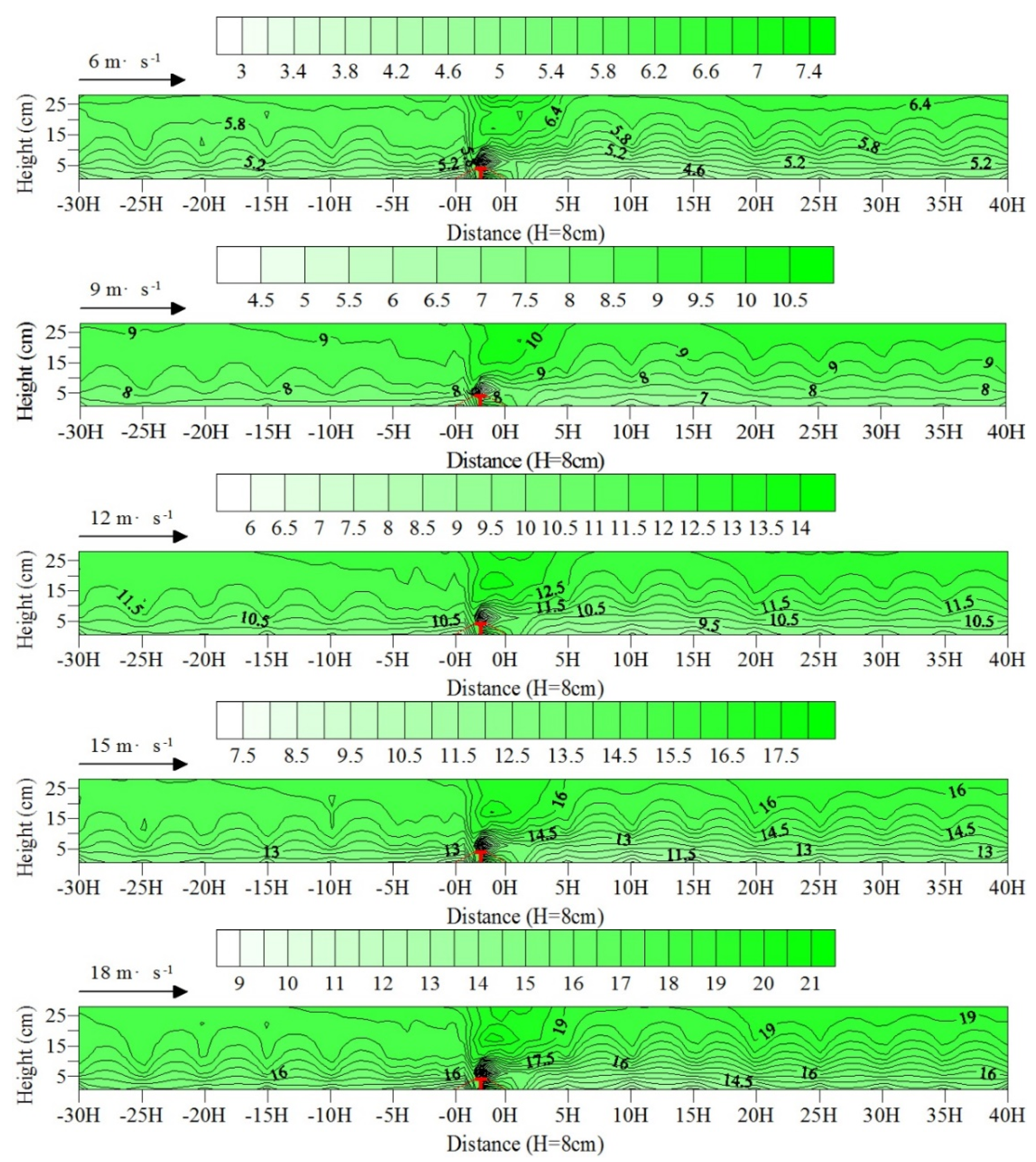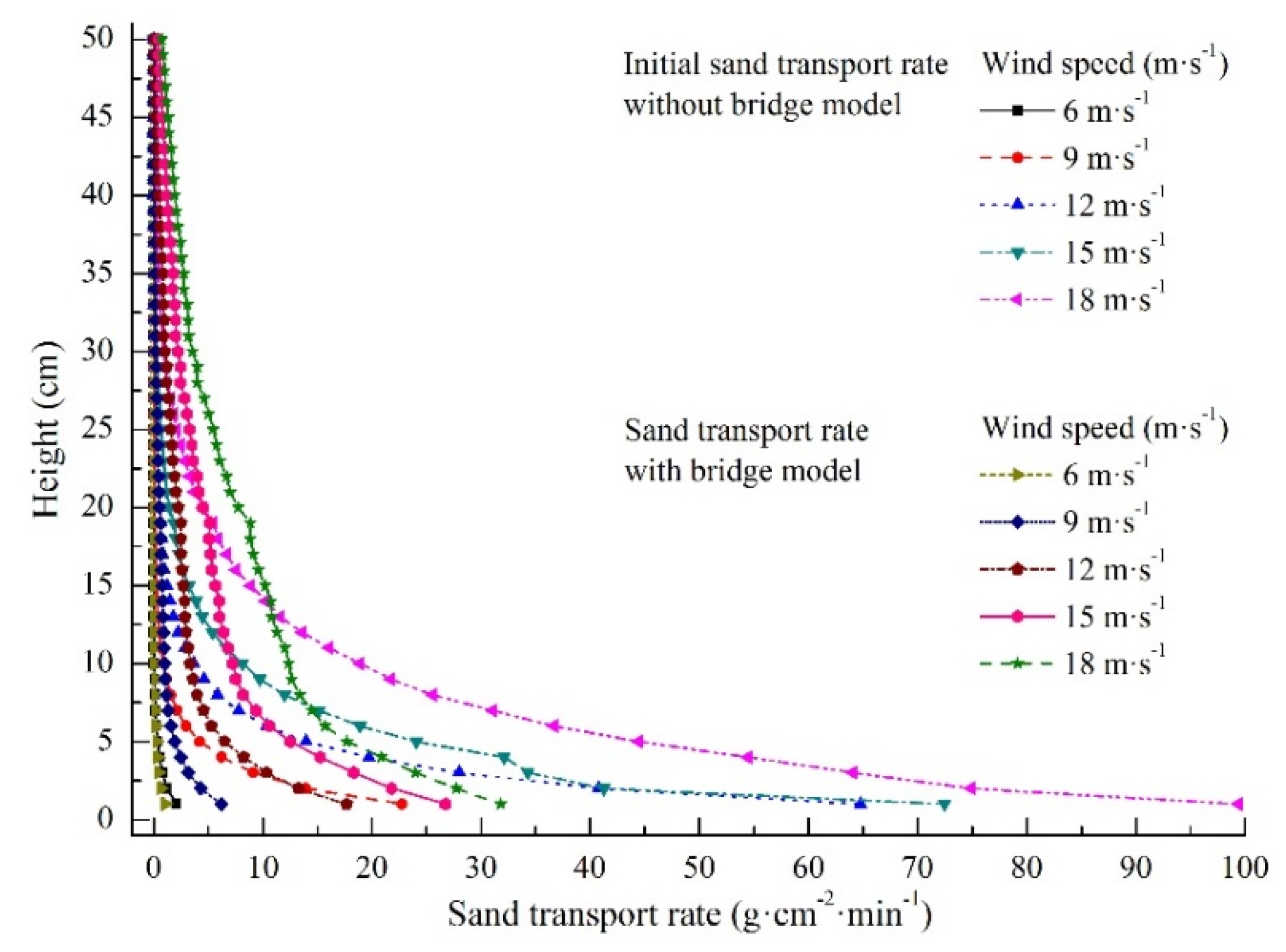Wind Dynamic Environment and Wind Tunnel Simulation Experiment of Bridge Sand Damage in Xierong Section of Lhasa–Linzhi Railway
Abstract
:1. Introduction
2. Methods
2.1. Field Observation
2.2. Wind Tunnel Simulation Experiment
3. Results and Analysis
3.1. Blown Sand Dynamic Environment
3.2. Influence of Railway Bridge on Wind Speed and Flow Field
4. Discussion
5. Conclusions
Author Contributions
Funding
Acknowledgments
Conflicts of Interest
References
- Dong, G.R.; Dong, Y.X.; Li, S.; Jin, J.; Jin, H.L.; Liu, Y.Z. The causes and developmental trend of desertification in the middle reaches of the Yarlung Zangbo River and its two tributaries in Xizang. Chin. Geogr. Sci. 1995, 5, 355–364. [Google Scholar] [CrossRef]
- Li, S.; Dong, G.R.; Shen, J.Y.; Yang, P.; Liu, X.W.; Wang, Y.; Jin, H.L.; Wang, Q. Formation mechanism and development pattern of aeolian sand landform in Yarlung Zangbo River valley. Sci. China 1999, 42, 272–284. [Google Scholar] [CrossRef]
- Liu, Z.M.; Zhao, W.Z. Shifting sand control in central Tibet. Ambio 2001, 30, 376–380. [Google Scholar] [PubMed]
- Liu, Y.; Wang, Y.S.; Shen, T. Spatial distribution and formation mechanism of aeolian sand in the middle reaches of the Yarlung Zangbo River. J. Mt. Sci. 2019, 16, 1987–2000. [Google Scholar] [CrossRef]
- Zou, C. Exploration on the engineering geological problems of the new Lhasa-Linzhi railway. J. Railw. Eng. Soc. 2016, 33, 26–30, (In Chinese with English Abstract). [Google Scholar]
- Yang, M.X.; Yao, T.D.; Gou, X.H.; Hirose, N.; Fujii, H.Y.; Hao, L.S.; Levia, D.F. Diurnal freeze/thaw cycles of the ground surface on the Tibetan Plateau. Chin. Sci. Bull. 2007, 52, 136–139. [Google Scholar] [CrossRef]
- Zhu, C.X.; Fan, X.; Bai, Z.K. Spatiotemporal pattern of wind erosion on unprotected topsoil replacement sites in mainland China. Sustainability 2020, 12, 3237. [Google Scholar] [CrossRef] [Green Version]
- Cheng, H.; Liu, C.C.; Li, J.F.; Zou, X.Y.; Liu, B.; Kang, L.Q.; Fang, Y. Wind erosion mass variability with sand bed in a wind tunnel. Soil Tillage Res. 2017, 165, 181–189. [Google Scholar] [CrossRef]
- Xie, S.B.; Qu, J.J.; Xu, X.T.; Pang, Y.J. Interactions between freeze-thaw actions, wind erosion desertification, and permafrost in the Qinghai-Tibet Plateau. Nat. Hazards 2017, 85, 829–850. [Google Scholar] [CrossRef]
- Xie, S.B.; Qu, J.J.; Zhang, K.C.; Mu, Y.H.; Xu, X.T.; Pang, Y.J.; Wang, T. Hydrothermal variation and its influence on the desertified ground surface of Qinghai-Tibet Plateau. Appl. Therm. Eng. 2018, 131, 201–208. [Google Scholar] [CrossRef]
- Zou, X.Y.; Li, S.; Zhang, C.L.; Dong, G.R.; Dong, Y.X.; Yan, P. Desertification and control plan in the Tibet Autonomous Region of China. J. Arid Environ. 2002, 51, 183–198. [Google Scholar]
- Zhang, C.L.; Zou, X.Y.; Yang, P.; Dong, Y.X.; Li, S.; Wei, X.H.; Yang, S.; Pan, X.H. Wind tunnel test and 137Cs tracing study on wind erosion of several soils in Tibet. Soil Tillage Res. 2007, 94, 269–282. [Google Scholar] [CrossRef]
- Dong, M.; Yan, P.; Liu, B.L.; Wu, W.; Meng, X.N.; Ji, X.R.; Wang, Y.; Wang, Y.J. Distribution patterns and morphological classification of climbing dunes in the Qinghai-Tibet Plateau. Aeolian Res. 2018, 35, 58–68. [Google Scholar] [CrossRef]
- Zhang, J.Q.; Zhang, C.L.; Li, Q.; Pan, X.H. Grain-size distribution of surface sediments of climbing and falling dunes in the Zedang valley of the Yarlung Zangbo River, southern Tibetan plateau. J. Earth Syst. Sci. 2019, 128, 11. [Google Scholar] [CrossRef] [Green Version]
- Bagnold, R.A. The Physics of Blown Sand and Desert Dunes; Dover Publications Inc.: Mineola, NY, USA, 2005; pp. 57–76. [Google Scholar]
- Ling, Y.Q. Engineering calculation of maximum possible sand transporting quantity. J. Desert Res. 1997, 17, 362–368, (In Chinese with English Abstract). [Google Scholar]
- Ling, Y.Q. The distributive heterogencity of sand-transporting quantity (rate) along horizontal direction. J. Exp. Mech. 1994, 9, 352–356, (In Chinese with English Abstract). [Google Scholar]
- Han, Q.J.; Qu, J.J.; Dong, Z.B.; Zhang, K.C.; Zu, R.P. Air density effects on aeolian sand movement: Implications for sediment transport and sand control in regions with extreme altitudes or temperatures. Sedimentology 2015, 62, 1024–1038. [Google Scholar] [CrossRef]
- Han, Q.J.; Qu, J.J.; Dong, Z.B.; Zu, R.P.; Zhang, K.C.; Wang, H.T.; Xie, S.B. The effect of air density on sand transport structures and the adobe abrasion profile: A field wind-tunnel experiment over a wide range of altitude. Bound. Layer Meteorol. 2014, 150, 299–317. [Google Scholar] [CrossRef]
- Musick, H.B.; Trujillo, S.M.; Truman, C.R. Wind-tunnel modelling of the influence of vegetation structure on saltation threshold. Earth Surf. Process. Landf. 1996, 21, 589–605. [Google Scholar] [CrossRef]
- White, B.R. Laboratory simulation of aeolian sand transport and physical modeling of flow around dunes. Ann. Arid Zone 1996, 35, 187–213. [Google Scholar]
- Snyder, W.H. Similarity criteria for the application of fluid models to the study of air pollution meteorology. Bound. Layer Meteorol. 1972, 3, 113–134. [Google Scholar] [CrossRef]
- Dong, Z.B.; Qinan, G.Q.; Lu, P.; Luo, W.Y.; Wang, H.T. Turbulence fields in the lee of two-dimensional transverse dunes simulated in a wind tunnel. Earth Surf. Process. Landf. 2009, 34, 204–216. [Google Scholar] [CrossRef]
- Xin, G.W.; Huang, N.; Zhang, J. Wind-tunnel experiment on sand deposition mechanism and optimal measures of wind-break wall along railway in strong wind area. Chin. J. Theor. Appl. Mech. 2020, 52, 635–644, (In Chinese with English Abstract). [Google Scholar]
- Bruno, L.; Horvat, M.; Raffaele, L. Windblown sand along railway infrastructures: A review of challenges and mitigation measures. J. Wind Eng. Ind. Aerodyn. 2018, 177, 340–365. [Google Scholar] [CrossRef]
- Yan, M.; Wang, H.B.; Zuo, H.J.; Li, G.T. Wind tunnel simulation of an opencut tunnel airflow field along the Linhe-Ceke Railway, China. Aeolian Res. 2019, 39, 66–76. [Google Scholar] [CrossRef]
- Wang, X.M.; Chen, G.T. Efficiencies and reasonable width for the mechanical sand-prevention system along the Tarim desert highway. J. Arid Land Resour. Environ. 1997, 11, 28–35, (In Chinese with English Abstract). [Google Scholar]
- Li, S.Y.; Wang, D.; Lei, J.Q. Spatial distribution of sand drift disasters on road surface in the hinterland of the Taklimakan Desert. Arid Land Geogr. 2005, 28, 93–97, (In Chinese with English Abstract). [Google Scholar]
- Zhang, K.C.; Qu, J.J.; Han, Q.J.; Xie, S.B.; Kai, K.; Niu, Q.H.; An, Z.S. Wind tunnel simulation of windblown sand along China’s Qinghai–Tibet Railway. Land Degrad. Dev. 2014, 25, 244–250. [Google Scholar] [CrossRef]
- Xiao, J.H.; Yao, Z.Y.; Qu, J.J. Influence of Golmud–Lhasa section of Qinghai–Tibet Railway on blown sand transport. Chin. Geogr. Sci. 2015, 25, 39–50. [Google Scholar] [CrossRef]
- Xie, S.B.; Qu, J.J.; Han, Q.J.; Pang, Y.J. Experimental definition and its significance on the minimum safe distance of blown sand between the proposed Qinghai–Tibet Expressway and the existing Qinghai–Tibet Railway. Sci. CHINA Technol. Sci. 2020, 63. [Google Scholar] [CrossRef]
- Fryberger, S.G.; Dean, G. Dune forms and wind regime. In A Study of Global Sand Seas; U.S. Geological Survey Professional Papers 1052; Mckee, E.D., Ed.; University Press of the Pacific: Honolulu, HI, USA, 1979; pp. 137–169. [Google Scholar]
- Cornells, W.M.; Gabriels, D. Optimal windbreak design for wind-erosion control. J. Arid Environ. 2005, 61, 315–332. [Google Scholar] [CrossRef]
- Dong, Z.B.; Luo, W.Y.; Qian, G.Q.; Lv, P.; Wang, H.T. A wind tunnel simulation of the turbulence fields behind upright porous wind fences. J. Arid Environ. 2010, 74, 193–207. [Google Scholar] [CrossRef]
- He, W.; Huang, N.; Xu, B.; Wang, W.B. Numerical simulation of wind-sand movement in the reversed flow region of a sand dune with a bridge built downstream. Eur. Phys. J. E 2018, 41, 53. [Google Scholar] [CrossRef] [PubMed]
- Huang, N.; Gong, K.; Xu, B.; Zhao, J.; Dun, H.C.; He, W.; Xin, G.W. Investigations into the law of sand particle accumulation over railway subgrade with wind-break wall. Eur. Phys. J. E 2019, 42, 145. [Google Scholar] [CrossRef] [PubMed]













| Xierong Grand Bridge | Length (m) | Width (m) | Average Height (m) | Number of Piers |
| 1192 | 3.9 | 8 | 36 |
| Month (Year/Month) | RDD (°) | Direction | RA (°) | Direction |
|---|---|---|---|---|
| 2017/09 | 318.85 | NW | 312.79 | NW |
| 2017/10 | 321.34 | NW | 320.20 | NW |
| 2017/11 | 266.64 | W | 243.04 | WSW |
| 2017/12 | 204.63 | SSW | 203.19 | SSW |
| 2018/01 | 304.84 | NW | 303.22 | WNW |
| 2018/02 | 10.89 | N | 3.87 | N |
| 2018/03 | 210.57 | SSW | 208.91 | SSW |
| 2018/04 | 206.24 | SSW | 203.80 | SSW |
| 2018/05 | 226.30 | SW | 221.33 | SW |
| 2018/06 | 318.72 | NW | 312.99 | NW |
| 2018/07 | 291.90 | WNW | 278.85 | W |
| 2018/08 | 330.61 | NNW | 332.11 | NNW |
| Wind Speed Range (m·s−1) | 5–6 | 6–7 | 7–8 | 8–9 | 9–10 | 10–11 | 11–12 | 12–13 | 13–14 |
|---|---|---|---|---|---|---|---|---|---|
| Sept 2017 to Aug 2018 Q (kg·m−1·a−1) | 3.45 | 11.92 | 15.37 | 10.14 | 7.26 | 5.25 | 2.36 | 1.38 | 0.75 |
© 2020 by the authors. Licensee MDPI, Basel, Switzerland. This article is an open access article distributed under the terms and conditions of the Creative Commons Attribution (CC BY) license (http://creativecommons.org/licenses/by/4.0/).
Share and Cite
Xie, S.; Qu, J.; Han, Q.; Pang, Y. Wind Dynamic Environment and Wind Tunnel Simulation Experiment of Bridge Sand Damage in Xierong Section of Lhasa–Linzhi Railway. Sustainability 2020, 12, 5689. https://doi.org/10.3390/su12145689
Xie S, Qu J, Han Q, Pang Y. Wind Dynamic Environment and Wind Tunnel Simulation Experiment of Bridge Sand Damage in Xierong Section of Lhasa–Linzhi Railway. Sustainability. 2020; 12(14):5689. https://doi.org/10.3390/su12145689
Chicago/Turabian StyleXie, Shengbo, Jianjun Qu, Qingjie Han, and Yingjun Pang. 2020. "Wind Dynamic Environment and Wind Tunnel Simulation Experiment of Bridge Sand Damage in Xierong Section of Lhasa–Linzhi Railway" Sustainability 12, no. 14: 5689. https://doi.org/10.3390/su12145689
APA StyleXie, S., Qu, J., Han, Q., & Pang, Y. (2020). Wind Dynamic Environment and Wind Tunnel Simulation Experiment of Bridge Sand Damage in Xierong Section of Lhasa–Linzhi Railway. Sustainability, 12(14), 5689. https://doi.org/10.3390/su12145689





